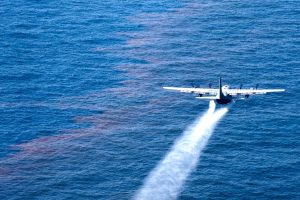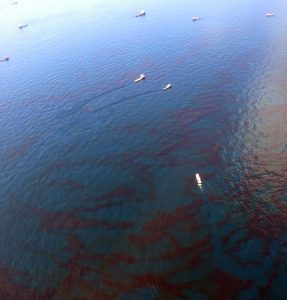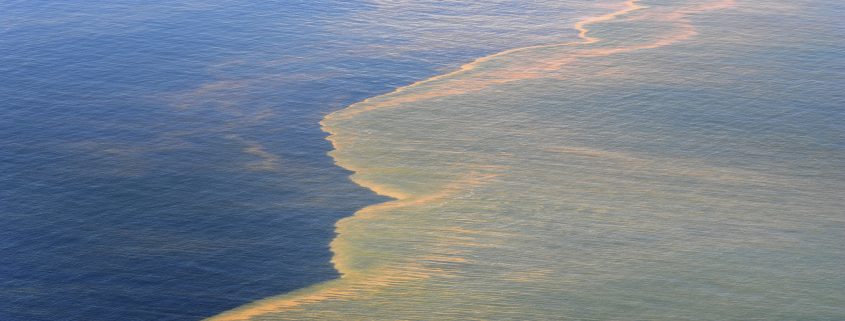Dispersants: A Modern Method For Cleaning Up Oil Spills: Advantages and Disadvantages
By Nicole Suren, SRC intern
In 2010, the Deepwater Horizon oil rig in the depths of the Gulf of Mexico exploded, causing the release of approximately 500 thousand tons of crude oil into the ocean in the second largest oil spill in global history, commonly known as the BP oil spill (Fingas, 2013). This spurred constant media coverage of the spill itself, as well as the cleanup. Oil spill cleanup generally includes several main steps: first the spill is contained using booms, then oil is absorbed on a large scale and skimmed off the ocean surface using boats and large amounts of absorbent materials (often more booms), and finally materials called sorbents are added to the water to remove trace amounts of oil not visible to the naked eye. What was unique about the cleanup of the Deepwater Horizon spill was the incredibly high amount of compounds called dispersants used before and during the official cleanup. Dispersion is when fine droplets of oil are transferred into the water column by wave action or turbulence (Fingas, 2013), removing oil from large slicks at the surface and allowing it to diffuse into deeper parts of the ocean. Dispersants are compounds usually sprayed on oil slicks that promote the formation of small droplets of oil, making dispersion much easier when waves stir up the oil. BP’s heavy use of dispersants was very controversial because dispersants had never been used on such a large scale before. Scientists were uncertain about two main things: 1) the effectiveness of dispersion as a cleanup method, and 2) the potential toxicity of dispersants on their own and/or mixed with oil. Since 2010, a significant amount of progress has been made in determining the effectiveness and toxicity of dispersants.

An airplane spraying dispersants over an oil slick in the Gulf of Mexico (Source: Wikimedia Commons)
The petroleum industry is confident that dispersants are helpful in cleaning up oil spills (Schrope, 2013). Independent scientists, however, have not found data on the subject to be quite as conclusive. The effectiveness of dispersants depends on a variety of factors, including the type of oil, wave energy, and the amount of dispersant added. Dispersants are never 100% effective, meaning they never cause 100% of the oil from an oil slick to disperse, and even after the initial dispersal has occurred oil can often resurface within a day or so to reform the slick (Fingas, 2013). A study funded by Exxon Mobil describes a very optimistic outlook on the effectiveness of dispersants, saying that oil degrades faster when dispersed than when on shore (degradation by bacteria can occur within a matter of weeks when dispersed, according to the study) and that despite the fact that the dispersants have been shown to remove close to 50% of the oil from an oil slick in EPA-approved lab tests, they remove closer to 95% of oil in large wave tank experiments, leading Exxon’s scientists to believe that EPA estimations of effectiveness greatly underestimate effectiveness in the field (Prince, 2015). Biodegradation is a term that describes the degradation of a material by bacteria, and it is an important concept in relation to the effectiveness of dispersants. Petroleum companies argue that the increased surface area of the oil provided by dispersants allows bacteria greater access to the oil, and therefore biodegradation can occur more quickly (Prince, 2015). However, this assessment does not take into account other materials like tar that are not so easily degraded by bacteria or dispersed. Furthermore, each species of bacteria that can use oil as a food source “can utilize only a few related compounds at most, [so] broad-spectrum degradation does not occur.” (Fingas, 2013) Since degradation is not complete, dispersed oil can then be sequestered at the bottom of the ocean in association with marine snow (organic materials that rain down to the deepest parts of the ocean from the surface). In the presence of dispersants, the amount of marine snow increases dramatically and includes droplets of oil, creating an oily sludge along the ocean floor that is not being degraded by bacteria (Justine S. van Eeenennaam, 2016).

An oil slick untreated by dispersants being cleaned up by skimmer boats. The oil appears very dark and dense from the surface. (Source: Wikimedia Commons)

An oil slick treated by dispersants. The color of the oil slick appears much lighter from the surface, as a lighter or coffee-colored oil slick is typical of the appearance of dispersed oil. May 6, 2010, is an aerial view of the Deepwater Horizon oil spill off the coast of Mobile, Ala., taken from a U.S. Coast Guard HC-144 Ocean Sentry aircraft. (U.S. Navy photo by Mass Communication Specialist 1st Class Michael B. Watkins/Released)
Not only is this sludge problematic because it is stopping the biodegradation of the oil touted by Exxon’s study, but it is toxic to the organisms that become buried below it (Justine S. van Eeenennaam, 2016). Toxicity of dispersants is a major concern, and several studies have shown that dispersants can compound a toxic situation created by the initial oil spill. First, increased biodegradation is promoted as an ideal solution for oil cleanup facilitated by dispersants, but “the aquatic toxicity of the biodegradation products is sometimes greater than that of the parent compounds,” (Fingas, 2013) so while the dispersants themselves are less toxic than oils by a magnitude of ten (Fingas, 2013), (Prince, 2015), they facilitate the production of more toxic compounds. The Exxon study also claims that dispersants show neither androgen nor estrogen receptor activity (Prince, 2015), meaning that they do not have any effect on regular endocrine function of organisms that consume or come in contact with them. While this is true for the dispersants used in the Deepwater Horizon spill, it is certainly not true for all dispersants (Richard S. Judson, 2010). Many dispersants have also been shown to be lethal to cells in culture, suggesting that they are toxic to larger animals as well (Richard S. Judson, 2010), and they can persist in the water column for years, rather than break down quickly as predicted (Helen K. White, 2014). In short, dispersants are not innocuous tools for cleanup, but have significant environmental effects that cannot be ignored.
The main benefit of dispersants is that their use can prevent large slicks of oil from contaminating coastal ecosystems and adversely affecting sensitive species like sea birds. However, “the use of dispersants remains a trade-off between toxicity to aquatic life and saving birds and shoreline species.” (Fingas, 2013) No matter what, introducing oil to an ecosystem will adversely affect that ecosystem. Because biodegradation is a questionably effective method of oil removal from marine ecosystems, the use of dispersants is essentially humans choosing which ecosystems should be more or less adversely affected, and since we see and interact with coastal ecosystems far more than deep ocean systems it is no surprise that dispersants are used to protect coastlines. However, the ecological impact of degrading deep water ecosystems should not be underestimated, and the effect of dispersants should be monitored long-term to determine whether they should be used again.
Works cited
Fingas, M. (2013). The Basics of Oil Spill Cleanup (3 ed.): CRC Press.
Helen K. White, S. L. L., Sarah J. Harrison, David M. Findley, Yina Liu, Elizabeth B. Kujawinski. (2014). Long-Term Persistance of Dispersants following the Deepwater Horizon Oil Spill. Environmental Science and Technology Letters, 1(7), 295-299.
Justine S. van Eeenennaam, Y. W., Katja C.F. Grolle, Edwin M. Foekema, AlberTinka J. Murk. (2016). Oil spill dispersants induce formation of marine snow by phytoplankton-associated bacteria. Elsevier, 104, 294-302.
Prince, R. C. (2015). Oil Spill Dispersants: Boon or Bane? Environmental Science and Technology, 49(11), 6376-6384.
Richard S. Judson, M. T. M., David M. Reif, Keith A. Houck, Thomas B. Knudsen, Daniel M. Rotroff, Menghand Xia, Srilatha Sakamuru, Ruili Huang, Paul Shinn, Christopher P. Austin, Robert J. Kavlock, David J. Dix. (2010). Analysis of Eight Oil Spill Dispersants Using Rapid, In Vitro Tests for Endocrine and Other Biological Activity. Environmental Science and Technology, 44(15), 5979-5985.
Schrope, M. (2013). Researchers debate oil-spill remedy: oil industry maintains that dispersants should be part of routine response to deep-water blowouts. Nature, 461.




Leave a Reply
Want to join the discussion?Feel free to contribute!